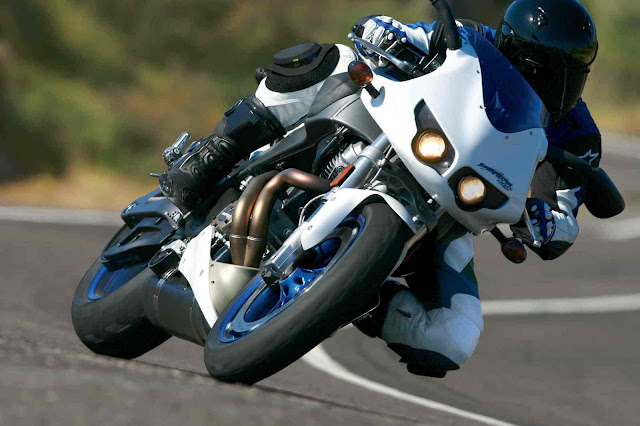Buell Firebolt XB9R
Despite its relatively conventional look, the Firebolt was arguably even more radical than previous Buells. As well as its exhaust muffler’s familiar location under the engine, the XB9R featured an aluminium twin- spar frame that held the fuel, plus a swingarm that doubled as the oil tank. The big perimeter front brake ‘disc was also both innovative and eye-catching.
Buell motorcycles have always been different. Since former racer and Harley engineer Erik Buell began building bikes m a W\sm\sm sbtd m . Uis fvrav’s machines have featured Harley-Davidson V-twin engines, zany styling and curious chassis features such as the rear shock underneath the engine. But even by Buell’s standards the XB9R Firebolt was something special.
At first glance the Firebolt looked almost conventional, because its frame was a twin-spar aluminium construction. But Buell hadn’t sold out and become normal. That frame also held the fuel inside its beams. This allowed a dummy petrol tank that held air. so there was no need for previous Buell models' sticking-out airbox. The swingarm, also made from aluminium, doubled as the oil tank. Further innovative features included a single perimeter front brake disc, bolted to the rim instead of the hub.
Erik’s background and the fact that Buell was by now 98 per cent owned by Harley, based nearby
in Wisconsin, meant that recent Buells had used tuned V-twin engines from Harley’s Sportster 1200. So did the Firebolt. though its 984cc air-cooled motor incorporated so many changes, including reduced capacity, that it was essentially new. Short- stroke dimensions allowed slightly higher revs, and a peak output of 92bhp at 7200rpm.
Buell’s clever partial rubber-mounting system allowed the motor to shake in one direction only, adding frame rigidity yet giving a smooth feel. Other chassis features included thick upside-down forks, a rear shock under the seat, and that unique front brake. The huge disc gave increased leverage at the six-piston caliper, and transmitted force directly to the wheel rim. This allowed the spokes and hub to be very light, contributing to the bike’s dry weight figure of just 385lb (175kg).
The Firebolt’s tiny fairing, shaped by British designer John Keogh, gave an aggressive, twin- headlamp stare that was backed-up by the bike’s racy riding position. That 92bhp output was modest by superbike standards, and the Firebolt struggled to match most middleweights in a straight line. But the pushrod V-twin had character, a fairly broad spread of torque, plus enough power for easy 85mph (137km/h) cruising and a top speed of about 135mph (217km/h). Its injection system was excellent, allowing very precise throttle control.
Equally importantly, the Buell’s light weight and compact dimensions made it brilliant fun on twisty roads and smooth racetrack curves alike. The Buell was as short as a 250cc racebike, and felt wonderfully agile, aided by excellent suspension, sticky radial tyres and near infinite ground clearance. That front brake bit hard, too, and delivered excellent feel at the lever.
Horsepower junkies were unimpressed by the Firebolt, but almost everyone who rode it was won over by its unique blend of style, flexibility and fine handling. It was certainly one modem sports bike that was well suited to being ridden hard on roads increasingly marred by traffic and speed cameras. The Buell was competitively priced, too, for a stylish, cleverly engineered, typically distinctive machine that proved once and for all that Americans could build outstanding sports bikes.
Final Flourish: the Buell 1125R
The success of the air-cooled XB9R and its 1203cc follow-up, the XB12R, led to hope that Buell would develop a bike with a more powerful liquid-cooled engine. In 2008 the firm launched the 1125R, powered by an 1125cc, 140bhp V- twin unit from Rotax of Austria. The R-bike was fast, with a top speed of over 150mph (241 km/h). But its styling was widely criticized, and it suffered from teething problems that delayed production and limited sales. Even so, the motorcycle world was shocked when parent company Harley- Davidson, hit by the global recession, closed the Buell Motorcycle Company in October 2009.
The Firebolt's distinctively shaped nose fairing gave an aggressive twin-headlamp stare as well as doing a fairly efficient job of protecting the rider from the wind.
When set up correctly the short, light Buell handled well enough to be competitive with more powerful bikes on a twisty road.
Specification Buell Firebolt XB9R (2002)
- Engine Air-cooled ohv pushrod four-valve 45-degree V-twin
- Capacity 984cc (88.9 x 79.8mm)
- Maximum power 92bhp @ 7200rpm
- Transmission Five-speed, belt final drive
- Frame Tubular steel
- Suspension Telescopic front, monoshock rear
- Brakes Perimeter disc front, disc rear
- Weight 4141b (175kg)
- Top speed 135mph (217km/h)



















0 comments: